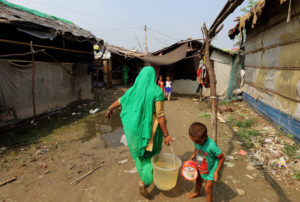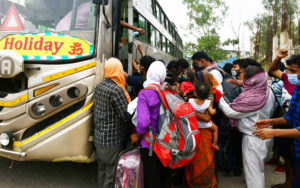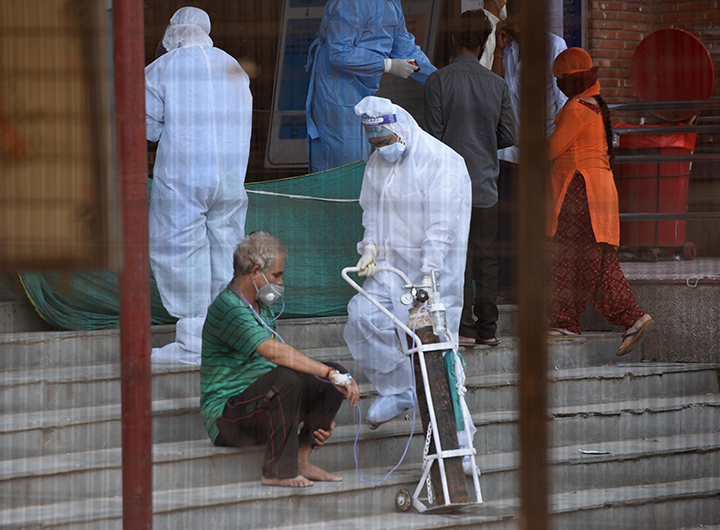A study has pushed Delhi down from 68th to 86th position in world rankings. The Delhi government’s inability to manage the pandemic better is a major reason
The thousands of migrants walking to bus terminals, queuing for a way home, symbolises just how unprepared Delhi — like the rest of India — to face a pandemic and the resulting lockdown. Had Delhi been truly a ‘Smart City’, men, women and children would not have had to huddle up in thousands waiting for transport — or worse, walk home thousands of kilometers away.
The pandemic also laid bare the ineptitude of the city’s healthcare system, where we saw patients with symptoms of Covid-19 being refused admission by multiple hospitals. One instance even allegedly led to the death of an elderly man after he was denied admission by five hospitals in Delhi. Nurses and doctors complained about the lack of PPE kits. Times of India reported that from the 10 major public and private Covid care hospitals in the city, 2,109 healthcare workers contracted Covid-19, and at least 18 died.

In testing for Covid-19, some private labs were found conducting tests in violation of the guidelines, there were also delays in testing and delivery of test results. Now too, the crowds outside government hospitals decry how inefficiently it is able to maintain social distancing norms at the most critical space.
In a day and age when every family has at least one mobile phone, the communications breakdown was startling. Delhi government’s effort to feed thousands of the burdened residents of Delhi, who had been rendered jobless, with no income to buy basic necessities, did reach large swathes of people but left many out of the loop.
Even its arrangement to issue e-coupons to register for the public distribution system (PDS) led to confusion and exclusion. Not everybody has an internet connection. The government then resorted to providing physical desks for registration, hardly a model for Smart City.
Delhi’s unpreparedness to face a pandemic was the major reason for its drop in Smart City Index this year to the 86thrank from last year’s 68. The poor result was in fact mirrored by other Indian cities, with Hyderabad finding itself the 85th position, down from 67 in 2019, Mumbai was at 93rd place, well below the 2019 number of 78 and Bengaluru at 95th from 2019’s 79.
The index and its dismal ranking for Delhi emerged from a survey conducted by the Institute for Management Development (IMD), in collaboration with Singapore University for Technology and Design (SUTD). It said that the significant drop of Indian cities “can be attributed to the detrimental effect that the pandemic has had where the technological advancement was not up to date”. It went on to say that “they have suffered more from the pandemic because they were not prepared”.
Bruno Lanvin, President of the IMD Smart City Observatory said, “This year’s Smart City Index suggests that the cities that have been able to combine technologies, leadership and a strong culture of ‘living and acting together’ should be able to better withstand the most damaging effects of such crises.”
Professor Heng Chee Chan, Chairperson of the Lee Kuan Yew Centre for Innovative Cities at SUTD said that “Smart cities closer to the top of the rankings seem to deal with unexpected challenges of the devastating pandemic with a better outcome”.
Rumi Aijaz, Senior Fellow at Observer Research Foundation, tells us that the report writers may have arrived at the conclusion based on review of select indicators, and their understanding of conditions prevailing in developing nations’ cities.

But he views the ‘smartness’ of the cities a little differently, saying that in the case of India, “and considering the social and economic conditions of the population in this part of the world, technology cannot be the sole reason for achieving the smart cities goal.”
“Thus, equal importance is to be given to other determinants, such as rational decision-making on city vision, city planning, resource mobilisation, plan and project implementation, city management and governance, citizen’s behaviour and response to government initiatives. Indian cities show many deficiencies in this regard, and each of these aspects needs to be properly addressed.”
In the report cited, hundreds of citizens from 109 cities were surveyed in April and May 2020 and asked questions on the technological provisions of their city across five key areas: health and safety, mobility, activities, opportunities and governance.
But much like the previous year, the top priority for residents in Delhi and what they feet is the most urgent need to address is air pollution (71%) followed by basic amenities (50%) and then security (48.3%).
Days of clear skies numbered
From 15 indicators that the respondents perceive as the priority areas for their city, all four cities’ residents in India highlighted air pollution as one of the key areas that they felt their city needed to prioritise on.
In 2019, Delhi’s air pollution got to an emergency crisis level. One not-so-fine day in November, the Ministry of Earth Sciences’ air quality monitor, SAFAR, said the city’s overall AQI had reached as high as 708, which is 14 times the safe level of 0-50.
And while the initial days of the lockdown had everyone rejoicing for one apparent benefit which were the blue skies of Delhi, the clear air was short lived. Now, satellite images from space agency NASA’s Fire Information for Resource Management System show farmers have started burning crop residue in parts of Punjab and Haryana. In Anand Parbat on 22 September, the AQI levels had already reached an ‘unhealthy’ level of 144 PM 2.5.
With the current situation not quite looking positive to see an end in stubble burning, the pressure that will be put on governments to combat its extreme affects will be huge. Coupled with the fact that the pandemic in the country and in the Capital, city is still raging, and Covid-19 is a respiratory disease, one that especially reaches into your respiratory tract, the general prognosis for the near future seems scary.
Indian Council of Medical Research (ICMR) had said in a report that air pollution caused one in eight deaths in India in 2018, and at the same time technologies to combat rising air pollution are yet to be enhanced. The Supreme Court instructed the Delhi government and the Central Pollution Control Board (CPCB) to erect smog towers for which it has collaborated with the Indian Institute of Technology, Bombay (IIT-B). These however, are nowhere to be seen on the horizon.
Furthermore, the plan to have fewer gas emitting vehicles on the roads may become a futile initiative with many commuters prefering to take out their own cars to seclude themselves from the general public.
At the School of Planning and Architecture, Sanjay Gupta, Professor and Head of Transport Planning, says that the city will see an increase of private vehicle usage for some time. This would mean greater use of two-wheelers and second-hand cars, whose market would receive a boost.
However, if the government departments that host Delhi and private corporations give their staff more work-from-home flexibility, some of Delhi’s maddening traffic may stay off the roads.
Another positive development is that Delhi Chief Minister Arvind Kejriwal launched the Electric Vehicle Policy with the ambitious objective that by 2024, 25% of all new vehicle registrations should be for EVs. The policy makes a case for incentives of up to Rs 1.5 lakh for the purchase of new electric cars in the city capital. An incentive of up to Rs 30,000 will be provided for e-two-wheelers, autos, e-rickshaws and freight vehicles.

Basic needs missed
Even though the Smart City Mission was launched in 2015, a small little portion of the Capital city was earmarked for it. Aijaz, in his report ‘The Smart Cities Mission in Delhi, 2015-2019: An Evaluation’ pointed out that just a 2.2 sq km of the NDMC area, designated as the New Delhi City Centre (NDCC), was selected for area-based development (ABD) over a ten-year period from 2015 to 2025.
As per the NDMC’s smart city proposal, 36 projects have been proposed for implementation.
Aijaz tells us that “Technological development and its use in Indian cities has been partial in most urban sectors, and hence people are not benefiting as much as they should. Therefore, further penetration of technologies and tech upgradation is certainly required.”
Even so, if we look at just the NMDC’s Smart City project, the municipal body’s effort to make itself more approachable and tech savvy does not seem to have worked so far. Its NDMC-311 app, which it says is “the most advanced citizen application for citizens of Delhi” and comes with “an exclusive range of features, allowing citizens to access enormous civic services,” including a 24×7 Helpline, has few takers and negligible appreciation.
The app store shows the application has just around 10,000 downloads and has received just 3.8 stars. Some of the reviews call it a “useless app” to lodge complaints and also the “worst app” as it has a “useless and complicated UI (user interface)”
Aijaz says that to transform the NDCC into a smart area, the agency must intensify efforts and expand the scope of their work to achieve this goal. “The end result of the ambitious programme should not just be implementation of a few technology-based projects but holistic development. Further, large parts of Delhi outside the NDMC area, under the jurisdiction of the three Municipal Corporations of Delhi (MCDs), exhibit an inferior quality of life and low levels of development. It is only when ‘smart’ solutions are also applied to such areas that Delhi can be truly considered a smart city.”
So Delhi where at least 1.8 million make up the population in slums, bereft of the basic amenities of clean drinking water in their homes, or sanitation facilities, is a long way away from being a Smart City like Singapore, which leads the Index.
Securing city’s safety
Delhi is infamous as the rape capital, with 2,168 registered cases in 2019. Has the capital used technology to make it safer?
The Delhi government on its part installed CCTV cameras in the city, and announced that from 1 September, buses would be equipped with CCTV cameras, panic buttons, and Global Positioning System (GPS).
We asked Delhi Police about the number of calls that came in via the women’s helpline number 1091 this year. According to their data, the total number of calls received in 2019 were 250. Comparing the previous year to this, we see that till 21 September, the total number of calls was 88 this year while in 2019 it was more than double that at 198.
However, this does not mean crime has gone down. Recognising the incidence of violence at home, WHO in its Q and A section has a section ‘Violence against women during COVID-19’.
In India during the lockdown, the National Commission for Women (NCW) registered 392 complaints of domestic violence in May, much higher than in 2019, which saw 266 such complaints. Furthermore, there were 73 cybercrime complaints involving women in May 2020, compared to 49 in May 2019. Rape and sexual assault complaints decreased 66% — from 163 in May last year to 54 this May. In 2019, they had decreased 17% from 198 in May 2018.
But that’s not saying that even more attacks aren’t taking place, with as many 93.1% of rape cases perpetrated by someone known to the victim, according to the National Crime Records Bureau (NCRB), the chances that a woman is unable to complain is high.
Oxfam India says that while NCW launched a WhatsApp number to provide an alternate method for women to report domestic abuse, the pandemic had created a host of issues for the victim which included the “Handicapped mediums of communication”. Elaborating, it said that although the WhatsApp number was launched it had a “limited reach as only 38% of women in India own phones and fewer have an internet connection, making this platform inaccessible to majority of women in the country.”
So while we analyse Delhi’s fall in Smart City Index, we must consider what technology can do to make it an equitable and safe city — which should be a focal point for government policies.
Patriot asked Smart Cities Mission under the Ministry of Housing and Urban Affairs on the Smart city Index and the progress of the city in its Smart City Mission. Below are some of the responses to our questions to Vikash Chandra, Finance and PPP Expert at the Smart City Mission Management Unit.
Q1. Would you say that the Smart City Mission faces a setback due to Covid-19 pandemic? If so, please elaborate.
The pandemic has been a true test of the belief India has reposed in its Smart Cities. The ongoing Covid-19 pandemic and national response can be sub-divided into three stages.
Stage 1 was the appearance of the disease through people with a travel history and 100% screening of foreign travellers in response.
Stage 2 was local transmission, when those who were infected and had a travel history spread the virus to close friends or family. National lock-down with efforts in contact racing, community surveillance and simultaneous built up of health infrastructure helped in controlling cases.
Stage 3 is extended transmission, with infections spreading to larger public and the source of the virus cannot be traced. At this stage, fully functional crisis management systems were put in place through simultaneous action on multiple fronts.
Smart Cities have contributed in building effective response mechanisms to prevent, contain and address the crisis confronting the nation. It was imperative to leverage data and technology in combination local intelligence, community collaboration and agile governance mechanisms.
To do this effectively, the Integrated Command and Control Centres (ICCCs) in smart cities, numbering 49 today, were converted into ‘war rooms’ that became essential nodes for collecting information, conducting predictive modelling, coordinating response and communicating with citizens.
Seeing the benefit from ICCCs in COVID-19 response, 33 other cities are now investing in developing these nerve centres to manage city operations beyond disaster management.
Q2. Has the pandemic exposed how Indian cities like Delhi –which fell from 68 rank in 2019 to 86 this year in the Smart City Index – are “unsmart”, taking into account that the report focused on how technology was playing a role in the Covid-19 era?
The Institute issues the 2020 Smart City Index for Management Development (IMD), in collaboration with Singapore University for Technology and Design (SUTD). MoHUA has no role in the same.
NDMC, which covers a part of Delhi, is one of the cities in the Smart Cities Mission. In the weekly rank of 100 Smart Cities, it is ranked 38 on week ending 18 September.
However, it is important to mention the role played by Smart Cities (using technology) during the Covid times. The efforts of Smart Cities during Covid can be clustered in four brackets:
- Management: Testing and quarantine efforts in mapping of suspected cases to optimal lab location, no-contact sample collection, quarantine checks and geo-fence apps, food and shelter to vulnerable people, GIS case tracking.
- Communication: Inter-departmental exchanges, engaging doctors to counsel the patients through VC, online counselling for patients via app video calling, telemedicine helpline, citizens portal for complaints/SOS.
- Information: Preparing daily reports, sharing the Covid dashboard with citizens and media, app for video consultations, checking/clarifying rumours, availability of emergency facilities/beds.
- Preparedness: Predictive modelling used to prepare for adequate medical infrastructure including kits, beds, quarantine centres.
Some efforts made by the Smart Cities during the pandemic:
- Bhopal: Expedited test and follow-up via ICCC.
- Varanasi: Swacchh Kashi app, Surveillance cameras and drones used for lockdown monitoring and sanitisation, food distribution.
- Surat: Developed an app in 48 hours for early quarantine of travel history cases, extensive contact tracing.
- Bengaluru: Developed ICCC in 24 hours and converted it into Model Covid war-room with defined protocols, procedures.
- Chennai: Door-to door checkups done in micro-blocks of 500 houses for full city.
- Pune: Public awareness effort with media campaigns/VMDs.
Q3. In the pandemic induced lockdown, could the migrant crisis have been coped with better if our cities were smart? If so, in which sectors would you particularly want to focus on to make a city like Delhi ‘smarter’ showing what the crisis had entailed.
Covid is a global pandemic, which presented new challenges of our cities. Moreso, these challenges were dynamic and it varied across different cities.
All tiers of the Government are concentrating their effort to limit the spread of Covid-19. Though the challenges of COVID are not yet over, we are dealing with it smartly. The contribution to the GDP by our Indian cities is more than 65%, therefore it will be the Indian cities which will lead the revival of economy. We will have to see how more economic activities can get started in our cities as early as possible. However, its effects are much more serious on the ULBs which have the responsibility of managing the crises on the ground at war footing.
As a long-term measure, we will better equip our ULBs to strengthen the basic services like public health, sanitation and solid waste management. We have to make Urban India more resilient towards dealing with such crises.
(Cover: A medical worker helps move an oxygen tank being used by a person with breathing issues outside the Covid-19 ward, at Lok Nayak Jai Prakash Narayan Hospital // PHOTO: GETTY IMAGES)





